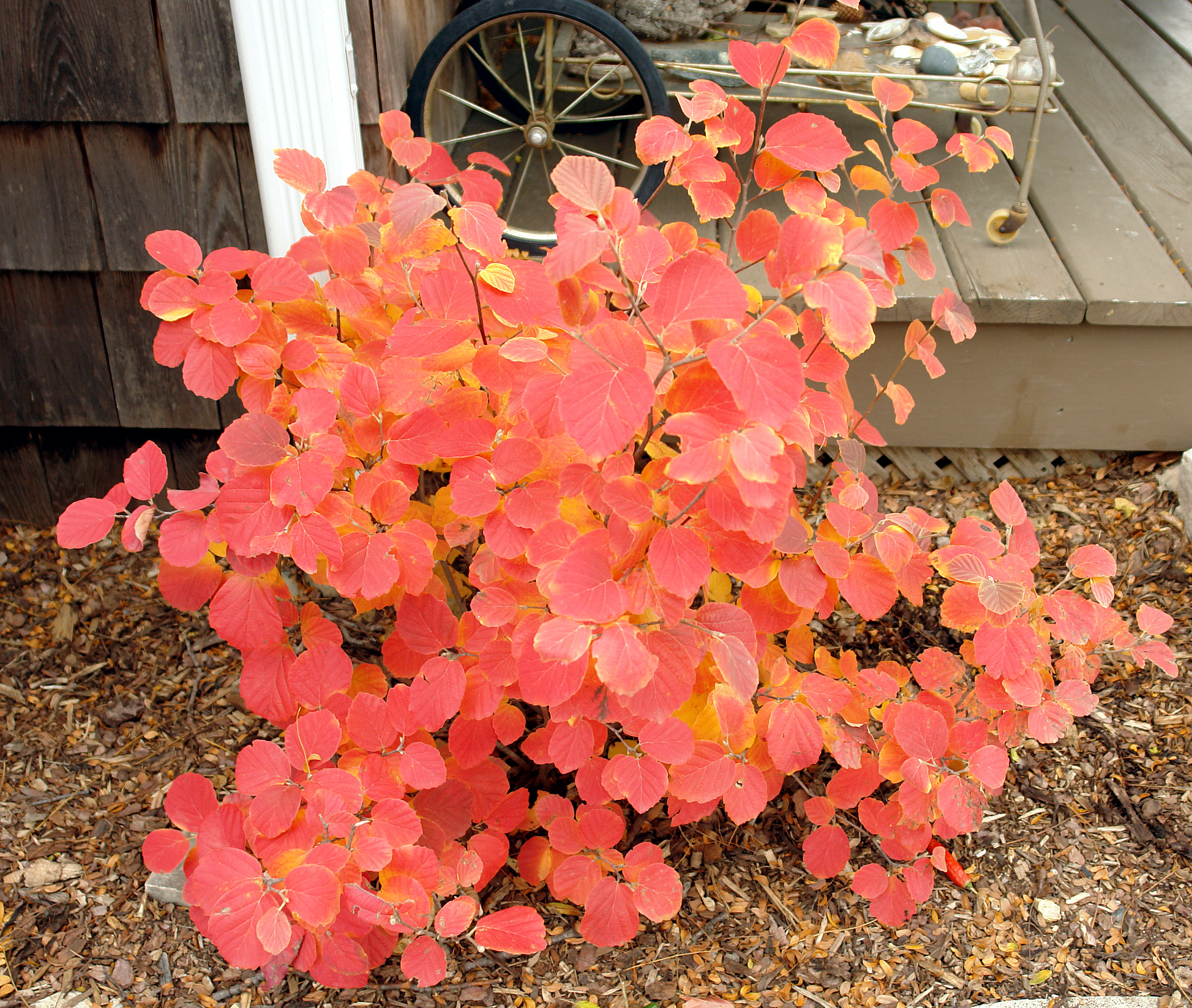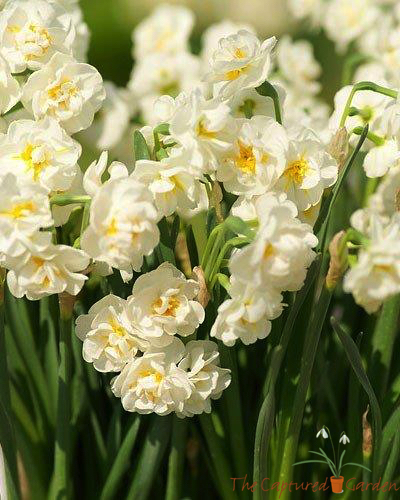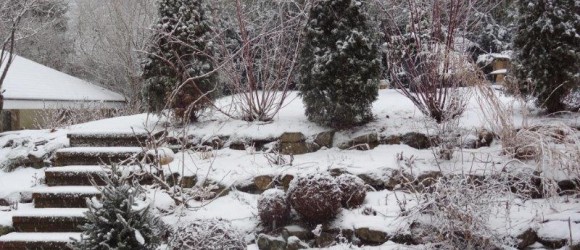Fothergilla
My Fall Plant Spotlight -Fothergilla.
One look at this deciduous shrub in fall and you’ll have to have one. It’s beautiful in the spring with white, fragrant bottle brush flowers appearing before the leaves. During the summer fothergilla’s textured leaves are a nice medium green.
But it is in late fall that this shrub shines. Orange, red, and yellow leaves combine on one knockout plant. Fothergilla will color best in full sun but can take some shade. One of my favorites for reliable color is ‘Mt Airy’.

Fothergilla major grows between 5-10 feet; fothergilla gardenii between 3-5. If you can’t decide which fall color you like best, why not plant a low-maintenance shrub that can give you them all?
A Perennial Favorite – Daffodils
Thinking of planting a perennial favorite? Here are a few tips.
 Do: Plant daffodils where they will get at least 6 hours of full sun even after trees leaf out. Sun on the leaves will provide energy for next year’s flowers.
Do: Plant daffodils where they will get at least 6 hours of full sun even after trees leaf out. Sun on the leaves will provide energy for next year’s flowers.
Do: Plant in well-drained soil. Daffodils hate wet feet and will tell you so by dying.
Do: Fertilize very lightly with an organic low-nitrogen fertilizer in early spring as shoots are starting to emerge.
Do: Try some new or even heirloom varieties. One of my favorites is a cream-colored double called ‘Bridal Crown’, shown here. Plant it near an entryway – its fragrance will knock your socks off.
Do: Buy bulbs from a reputable source. Bulbs need to be harvested and thoroughly dried before shipping, ideally that would make them available in September. A retail calendar that insists they show up in August should make you suspicious that they may not have cured long enough.
Don’t: Make the mistake of planting the bulb upside down. The pointed end goes up.
Don’t: Cut, braid or otherwise mutilate the leaves after flowering. Yes, it looks bad but the leaves need to capture as much energy as they can from the sun to bloom well next year. Wait at least 8 weeks after blooming to cut back. I like to plant daffodils among hostas; as the hostas grow their emerging leaves will hide the yellowing foliage.
The Importance of Good Bones
As I look out my window at the winter landscape I am thankful for good bones. Not mine, although they are helpful with all the shoveling I have been doing lately. I think here in Boston we are nearing a record for the snowiest winter ever recorded. I am thankful for the “bones” of my garden – plants that anchor the space four seasons a year. All too often we become enamored of flowers, when in actuality their beauty is fleeting. Even the most robust perennial will rarely reward you with more than a month or so of blooms. The beautiful peony, with its gorgeous flowers, will be bare within weeks, leaving you nothing but foliage prone to powdery mildew. Why build a garden around that kind of performer?
Bones provide visual interest even in the dead of winter and when I am creating a design for my clients they are the first place I start. After all, I live in New England where it sometimes seems that winter is the longest season. What will we be looking at in the garden from November until April? Often the bones I use are evergreen, like the ‘Centennial Girl’ holly and ‘DeGroot Spire’ arborvitae that stand watch over the sleeping perennials at their feet. Sometimes my “bones” have interesting bark or branches. A dusting of snow on the twisted branches of my Japanese Maple is magical. The beautiful peeling bark of Paperbark Maple (acer griseum) is beautiful when backlit by the winter sun. The bright red and yellow branches of dogwood (cornus sericea) shine against the snow. If your winter garden looks flat why not consider a redesign? Incorporate some evergreens with different shapes and textures. Add deciduous trees or shrubs with interesting bark, berries or branches.
Let’s face it winter in New England is long; having good bones can make it more bearable.
Busy as a Bee?
 Think about that expression for a minute. Yes, it’s May. It’s an extremely busy time of year: end-of-school field trips, graduations, first communions, bridal showers, weddings, first vacations of the summer, etc. Sometimes it’s hard to catch a breath.
Think about that expression for a minute. Yes, it’s May. It’s an extremely busy time of year: end-of-school field trips, graduations, first communions, bridal showers, weddings, first vacations of the summer, etc. Sometimes it’s hard to catch a breath.
Now consider the phrase “busy as a bee”. From the minute they are born worker bees, ironically all female, have a job. They work together for the good of the colony. In the beginning they might work in the nursery, later they could work as house security, protecting the hive, or as undertakers, removing dead bees. Once they mature bees are promoted to field agents to forage and collect nectar and pollen to feed the colony. All this busyness is beneficial to you because honeybees and other pollinators are directly responsible for every third bite of food you take. Imagine what life would be like without apples, almonds, or avocados? And that’s only the A’s. And did you know it takes 154 trips out to forage just to make one teaspoon of honey? Talk about busy! There is never a glass of wine on the porch or a game of badminton on the front lawn.
You may have heard huge numbers of colonies have been dying lately. This decline has been termed Colony Collapse Disorder and while the definitive causes are still unknown there are steps we can take to help the bees. Plant flowers that are good forage sources for the bees like summersweet, coneflower, milkweed and sedum, to name a few. Limit or abstain from using pesticides which have been shown to be detrimental to bee health. The tastiest thing you can do is buy local honey.
Spring is a busy time of year but make sure to take some time to smell the flowers. And appreciate the honey bee that might be working in the center of them.
Boston Flower and Garden Show
 You know what they always say about the most successful couples. “Opposites Attract”, which also happens to be the title of my Flower Show demonstration on Wednesday, March 12 at noon, during which I’ll show how to use contrast to create dynamic gardens and containers. For a full list of over 50 lectures and demonstrations, visit www.bostonflowershow.com/events-attractions/lectures-demos.
You know what they always say about the most successful couples. “Opposites Attract”, which also happens to be the title of my Flower Show demonstration on Wednesday, March 12 at noon, during which I’ll show how to use contrast to create dynamic gardens and containers. For a full list of over 50 lectures and demonstrations, visit www.bostonflowershow.com/events-attractions/lectures-demos.

Follow Us!